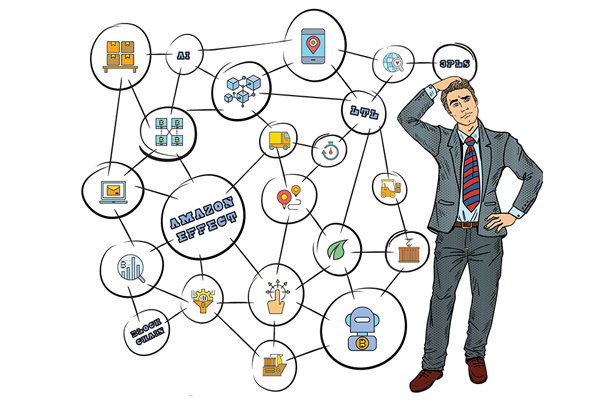Making Sense of Supply Chain Education

Class is in session! Professors at some of the country’s leading supply chain education programs join Inbound Logistics for a lesson in how they are preparing the next generation of professionals, whether they come from business programs or engineering schools, for tomorrow’s challenges.
Continuing Education for Urgent Needs
Trends
What are the latest trends in logistics education, and how does your program address them?
 Nehemiah Scott
Nehemiah Scott
Director, Supply Chain Management Program,
Gies College of Business,
University of Illinois at
Urbana-Champaign
One big trend is the development of a curriculum that helps students learn about and experience the breadth and depth of supply chain management. Our program requires students to complete a supply chain internship, which allows them to connect what they have learned in the classroom to how supply chain processes operate in the real world.
We prepare students to instantly begin adding value on their internship and expect that they learn new methods and technologies that they can use to contribute to their end-of-internship projects and future coursework in the program.
Another trend is the ever-growing challenge of aligning the curriculum with the real-world needs of manufacturing and non-manufacturing companies. To address this, we developed an SCM Corporate Affiliates Program with a group of world-class companies—Shell, Echo Global Logistics, Harting USA, Aldi, and others—that are our corporate partners in supply chain management education.
Ana Muriel
Director, Supply Chain Management Lab,
Department of Mechanical
and Industrial Engineering,
University of Massachusetts Amherst
A major trend that has profoundly changed logistics education—and engineering education in general—is experiential learning. Not only do most of our students participate in internship and research experiences, but they are also exposed to hands-on projects and case studies that allow them to apply the tools learned in creative ways at every step.
Data analytics continues to gain momentum. In our program, we are developing new courses on data analytics and machine learning, along with new classroom activities involving large data sets for our more traditional optimization-based courses. The latter go hand in hand with increased demand for data-driven decision-making.
In the era of big data, students need to understand the full cycle, from cleaning the data to devising an algorithm that will work with—and take full advantage of—the data at hand.
The application areas our programs expose students to are also evolving. Humanitarian logistics, the sharing economy, and the need for ever-faster delivery and quicker response to demand and supply fluctuations all provide timely topics to address in the classroom.
Nick Vyas
Executive Director
Center for Global Supply
Chain Management
Marshall School of Business
University of Southern
California
The supply chain is no longer what we used to think of as transportation and warehousing 30 or 40 years ago. It’s much more than that, so one trend is that there are so many new areas that we’ve made supply chain subjects.
To provide advanced acumen for operations excellence, we offer students from all business disciplines electives in emerging technology, data analysis, supply chain analytics, and supply chain finance. Schools have to have these components in their overall business curriculum so they can give non-supply chain students exposure to the supply chain and supply chain students exposure to other business areas.
That helps them all become much more well-rounded leaders.
Industry 4.0
How do you prepare students to see—and eventually promote—supply chain and logistics functions as centers for innovation and problem-solving?
Vyas: In addition to an annual global supply chain summit, case competition, and experiential trip, the Marshall School of Business sponsors an annual hackathon. Basically, we take one unique problem—typically it’s one confronting a large company or an infrastructure provider—and bring professionals and multidisciplinary (undergraduate and graduate) students together to participate. We say, ‘We have 24 hours to solve this problem. How would you address it?’
It’s incredible how everyone comes in with different backgrounds and takes different approaches. In the end, about 25-plus teams all approach the problem uniquely. This shows how you can leverage thinking in today’s world.
Scott: As technological advancements continue alongside the emergence of Industry 4.0, we see the innovative nature of supply chain and logistics more than we ever have before. It is imperative that students are up to speed on this.
We like to highlight innovation through coursework and discussions that contain examples from everyday experiences with the supply chain.
For instance, students immediately relate to e-commerce because for many, online shopping is the primary method for purchasing goods and services. But they may not realize the amount of supply chain innovation that takes place in, say, order fulfillment. We make sure students have an in-depth understanding of how the flexibility and choices they have as consumers are made possible by investments and innovations in the supply chain’s structure and processes.
We want students to understand that problem-solving is itself a process of innovation. One of the most rewarding problem-solving experiences comes in our practicum course, where students are required to work on real supply chain projects that companies looking for solutions assign and evaluate. Projects range from strategic and exploratory to data-intensive, requiring quantifiable outputs and rigorously tested conclusions.
Muriel: Students first see the value of innovation and problem-solving in supply chain and logistics when analyzing the groundbreaking strategies of companies such as Walmart, Amazon, UPS, and Dell. Our emphasis, however, is on providing a solid foundation in modeling and problem-solving, as well as software tools that are applicable to a wide range of settings. This way, they acquire the skills to devise creative, data-driven logistics strategies when faced with new challenges.
Just as important, projects and case studies based on real industry practice allow students to get hands-on experience and gain the confidence to tackle new situations and innovate.
Skill Sets
What do you hear from industry about its skill and knowledge needs, and how are you shaping the curriculum with these in mind?
Muriel: Our industry partners call for a mix of technical savvy, analytics know-how, leadership skills, and effective communication. Some also emphasize the importance of negotiation skills.
The major shift we see is greater focus on data analytics and interest in data-driven optimization. In response to these needs, we are offering new analytics, leadership, and project-management courses, requiring students to use various programming languages in a sequence of courses. We’re also introducing projects that involve large data sets.
Scott: I recently spoke to a senior vice president of supply chain, who talked about the skills missing in his workforce. He noted that a high-level superficial understanding of supply chain concepts is there, but the how-to knowledge is sometimes missing. This can include, but is not limited to, dependent and independent demand management, multi-echelon supply chain forecasting, sales and operations planning, inventory decision choices, category management, and sourcing decisions.
Our courses are designed to go deeper on these topics. For instance, if a student is hired as a sourcing analyst, we want to make sure they are equipped with the how-to knowledge of defining business requirements and the criteria for selecting and communicating with the best suppliers. If a student is hired as a logistics analyst, we want to make sure they know how to create or modify a model that optimizes crucial supply chain decisions, maximizes return, and minimizes risk for the company.
Our syllabi are designed to introduce concepts followed by the how-to knowledge component, whether through in-class activities, team-based simulations, data-based projects, case studies, or experiential learning opportunities. We love for our students to be in a position to demonstrate their understanding of the how-to component. We find that our students love it as well.
Another need is the ability to use new technologies to understand and derive insights from data. Our students get a lot of practice using data to make important decisions. At Gies College of Business, all students are required to take two data-analytics courses during their freshman and sophomore years.
Our program infuses context-specific, data-based approaches to solving real-world logistics problems into course plans. In courses such as logistics management and supply chain modeling, students are exposed to various mathematics, data analytics, statistics, optimization, and simulation modeling methods. They also learn the appropriate software tools to appropriately tackle complex supply chain problems.
Students must also technically, theoretically, and pragmatically support their arguments through a combination of nontechnical and technical report writing.
Vyas: Because of rapid transformation, companies are looking for graduates with a heavy data-science and technology background. They are seeking graduates to help digitize the company and enhance global connectivity.
I often find that legacy companies are stuck in this peculiar dilemma of trying to transform while continuing to manage the business. Disruptions are occurring all over, and they just don’t know how to move forward. The new generation of leaders will need to help companies shift from legacy-minded to cutting-edge without losing focus on day-to-day execution.
Big Picture
Students today are interested in sustainability and social justice—and the supply chain plays a big role in any company’s approach to these issues. How does your program prepare students for decision evaluation and decision-making related to these topics?
Vyas: Our program integrates a focus on sustainability and corporate social responsibility into the curriculum with new-age tools and methodology. We emphasize that decisions can no longer be based just on speed to market and cost.
Through case studies and work projects, we challenge students to look at the supply chain in a broader spectrum and ask big questions, such as how to take care of natural resources. In supply chain, we often can be myopic, so we are conscious to make sure we continue to create a well-rounded executive.
Muriel: We discuss the sustainability and social justice aspects of decisions across the curriculum as we analyze classic supply chain strategies or work on developing our own solutions to new problems. In their coursework and projects, students are specifically asked to address these issues. In some cases, the response is to build mathematical models that will account for these aspects.
As we get deep into devising algorithmic solutions to logistics problems, we aim to help students recognize that they cannot blindly follow or recommend solutions the computer generates. They need to analyze solutions across a variety of dimensions—such as the impact on the workforce, the community, and the environment—which underlying models may not capture.
Our mission as logistics engineers is to provide not a one-stop solution, but decision-support tools that allow students to explore different objectives and analyze various what-if scenarios in balancing competing goals.
Scott: We make sure our students can connect standard supply chain topics and concepts to pressing sustainability and social justice issues.
For example, in our logistics management and supply chain basics courses, we challenge students—through projects, cases, and in-class activities—to have critical conversations about hot-button topics that intersect with supply chain and logistics—everything from the impact that supply chains have on raw materials producers who may earn less than $2 per day to the connection between deforestation and consumer safety in supply chains, to discussing the role that companies and supply chains can take in eradicating forced labor.
Extra Credit
Given today’s diversified work environments, what “soft” skills do supply chain students need to succeed?
Muriel: The soft skills supply chain management students need include the ability to work effectively in diverse teams, so our program prepares them through group assignments and projects in every course and a final team capstone experience. We use team-making software to ensure teams are diverse.
Effective communication to a variety of audiences is also important. Students also need to learn and adapt as new challenges and technologies arise, so we provide a strong foundation that sets them up for lifelong learning, allowing them to seek and assimilate new information and tools.
Scott: As innovation continues and supply chains become longer, students must be relational and interpersonal, accepting of the similarities and differences they have with others. Effectively working with people from different backgrounds has never been more important.
In addition, students should be skillful in managing paradoxes. They must be able to balance being innovative and exploratory with being efficient in thought and action. We challenge students to become thought leaders willing to push the fold of innovative ideas within the supply chain field.
At the same time, students must be meticulous in their observation, critical thinking, and listening skills. Their work, both as a student and a future professional, should be a manifestation of these skills.
Continuing Education for Urgent Needs
In today’s rapidly changing marketplace, supply chain and logistics education providers have to be fast responders, up to speed not just on industry trends but also ahead of the curve on education innovations.
That’s because supply chain practitioners increasingly contend with everything from accelerating technology advances to transformations in customer expectations. Think Amazon’s promise to deliver products to the doorstep in the blink of an eye. “Everyone demands things they didn’t demand before,” says Brian Thompson, chief commercial officer of SMC3, which designs and provides education for the transportation industry.
Supply chain practitioners also find that once-routine functions have grown exponentially more complex. Where once something as important as pricing and costing was straightforward, it now requires a sophisticated framework for case-by-case analysis. “In the trucking supply chain, the lines between transportation modes and technology systems are increasingly fuzzy,” Thompson says. And negotiating fuzzy lines requires informed judgment.
Not so long ago, companies could rely on senior staff to teach younger employees the ropes and to cultivate the skills essential for troubleshooting. But with so many baby boomers retiring, many firms find themselves facing what Thompson calls a knowledge transfer gap.
Bridging that gap increasingly falls to organizations with an education mission. They’re designing new programs around specific skill sets and delivering them over platforms that afford participants maximum flexibility, including the ability to fit classwork into a busy schedule. SMC3, for example, is launching an online and interactive less-than-truckload certification program that covers everything from operations and business analytics to carrier pricing and costing. Highly specialized subjects like these might merit little more than a single introductory lecture during an undergraduate class, Thompson notes, but on the job they’re essential.
What’s also essential is immediate access to skills training and knowledge transmission. Shippers and service providers need education organizations to offer the same immediacy they must deliver to their own customers.


